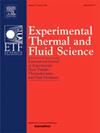The spraying characteristics of electrohydrodynamic atomization under different nozzle heights and diameters
IF 2.8
2区 工程技术
Q2 ENGINEERING, MECHANICAL
Experimental Thermal and Fluid Science
Pub Date : 2025-06-25
DOI:10.1016/j.expthermflusci.2025.111551
引用次数: 0
Abstract
Electrohydrodynamic atomization (EHDA), the atomization mode of variable electrohydrodynamic (EHD) spraying process, has been extensively studied and widely applied in assorted micro/nanoscopic engineering applications in recent years. However, many aspects of the rapidly changing liquid atomization behavior are not fully understood, especially that the impacts of nozzle height and diameter on the spraying characteristics of EHDA are quite lacking in the literature. In view of this, we performed an experimental work on EHDA under four most fundamental operating parameters including electric voltage, liquid flow rate, nozzle height, and nozzle diameter. Eight distinct spraying modes, namely Spindle, Pulsating Jet, Rotating Atomization, Pulsating Atomization, Stable Atomization, Tilted Atomization, Oscillating Jet, and Multi-jet were observed. The variations of spraying mode, Taylor cone length and angle, liquid jet breakup length, liquid jet rotating and pulsating frequency, atomization angle, and atomization area are analyzed in terms of electric Bond number and dimensionless flow rate, which are two most frequently used dimensionless variables in EHD spraying studies. Meanwhile, the influences of nozzle height and diameter on liquid spraying characteristics are also discussed. The Rotating Atomization and Pulsating Atomization modes are two newly discovered spraying modes that have not been reported in previous EHDA articles. The spraying characteristics of these two modes are examined in detail, which are also compared with those of the Stable Atomization mode obtained in this work, for the purpose of exploring their potential applications in the future.
研究了不同喷嘴高度和直径下电液动力雾化的喷涂特性
电流体动力雾化(EHDA)是可变电流体动力(EHD)喷涂过程的雾化方式,近年来在各种微纳工程应用中得到了广泛的研究和应用。然而,快速变化的液体雾化行为的许多方面尚未完全了解,特别是喷嘴高度和直径对EHDA喷涂特性的影响在文献中相当缺乏。鉴于此,我们在电压、液体流量、喷嘴高度和喷嘴直径四个最基本的工作参数下对EHDA进行了实验工作。观察到主轴喷射、脉动喷射、旋转喷射、脉动喷射、稳定喷射、倾斜喷射、振荡喷射和多射流8种不同的喷射模式。分析了喷射方式、泰勒锥长度和角度、射流破碎长度、射流旋转和脉动频率、雾化角和雾化面积在电键数和无因次流量这两个EHD喷射研究中最常用的无因次变量的变化规律。同时,还讨论了喷嘴高度和直径对液体喷射特性的影响。旋转雾化和脉动雾化模式是两种新发现的喷雾模式,在以前的EHDA文章中没有报道。详细研究了这两种模式的雾化特性,并与稳定雾化模式进行了比较,探讨了它们在未来的应用前景。
本文章由计算机程序翻译,如有差异,请以英文原文为准。
求助全文
约1分钟内获得全文
求助全文
来源期刊

Experimental Thermal and Fluid Science
工程技术-工程:机械
CiteScore
6.70
自引率
3.10%
发文量
159
审稿时长
34 days
期刊介绍:
Experimental Thermal and Fluid Science provides a forum for research emphasizing experimental work that enhances fundamental understanding of heat transfer, thermodynamics, and fluid mechanics. In addition to the principal areas of research, the journal covers research results in related fields, including combined heat and mass transfer, flows with phase transition, micro- and nano-scale systems, multiphase flow, combustion, radiative transfer, porous media, cryogenics, turbulence, and novel experimental techniques.
 求助内容:
求助内容: 应助结果提醒方式:
应助结果提醒方式:


